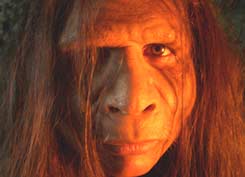The Human Hobbit
The Human Hobbit

The Discovery
On the island of Flores, in the Indonesian archipelago 375 miles east of Java, an amazing thing happened. A team of Australian archaeologists - led by Peter Brown, Mike Morwood, and Bert Roberts - stumbled on a 10,000 year old skeleton. At only 3 feet tall, they assumed they had found the skeleton of a young girl. But the evidence - worn teeth, wisdom teeth erupted - told quite a different story. They had discovered one of the smallest human adults ever found. It was hailed as the scientific sensation of the century.
As the excavation continued, things became stranger still: elephants the size of cows, rats the size of dogs, lizards the size of crocodiles. Everything small was large, everything large was small, as though they had stepped into some Sir Arthur Conan Doyle topsy-turvy Lost World.
Furthermore, the dates didn't make sense. 18,000 years ago, the modern Homo Sapien was supposed to be the only human species left on the planet. If not a modern human being then what? This question became a piece of the evolution puzzle, and the challenge was determining where the piece of the puzzle fit.
Actual Hobbit Skull

The Investigation
The remains were compared to possible ancestors. One by one, they all were eliminated. The skull most closely resembled Homo Erectus, but was only half his height. Most perplexing was evidence of sophisticated tools, weapons, and remains of a roasted pygmy elephant, implying hunting skills, teamwork, and possibly language, all of which set it far apart from other human species of the era.
They believed they had found a new species of human. They called her the Hobbit. But the mystery deepened. Despite signs of intelligence, the brain was smaller that a chimpanzee's. Everything challenged what we knew about humans. If she was a new species, we could throw everything else out with the prelapsarian bathwater.
Homo floresiensis

The Debate
Naturally, there was skepticism and resistance among scientists. University of Illinois stone tool specialist, Professor Jim Phillips, opined that "the stones [don't] fit the bones." He further argued that the tools were of a "modern human," and far more sophisticated than anything ever found from that time period. Professor Bob Martin, Field Museum of Chicago, posited that the brain was "worryingly small," and Professor Ann MacLarnon, University of Roehampton, London, called the specimen "a very odd fossil, particularly the size of the brain."
The discovery team counter-claimed that evolution on a remote island does not follow conventional wisdom. That is how, over thousands of years, a Homo Erectus became a small-bodied, small-brained Hobbit. Professor Martin disputes this, quipping, "Humans have lived on many islands without shrinking."
Liang Bua Cave

Adding Fuel to the Fire
Professor MacLarnon had a theory, and located a specimen known to have suffered from microcephaly, which can cause dwarfism, a small brain, and facial deformities which can easily be mistaken for primitive features. She then located the brain of a modern human known to have suffered from the disease and compared it to the Hobbit's brain. They were almost exactly the same. Perhaps, Professor MacLarnon propounded, the Hobbit was simply a specimen that had suffered from microcephaly. The skeptics pounced on this theory, agreeing that it fit the facts much better: Occam's razor realized.
The discovering team was nearly mortified. Their incredible find - one which would completely alter our understanding of the human species - was dissolving before their eyes, morphing into an embarrassment, a scientific joke. The team quickly returned to Flores to search for new evidence as the Hobbit war dragged on. Another set of bones was unearthed, examined, compared. They were the same. It would be against staggering odds for two individuals to be struck by microcephaly. Soon, bones from another seven individuals were unearthed. It seemed that she was a new species and was named Homo Floresiensis. But in science, things are not always as they seem.

The Beat Goes On...and On
New research from the Proceedings of the Royal Society B loudly proclaimed that "Homo floresiensis was nothing more than a population of Homo Sapiens that were endemic cretins"- (anthropology.net, March 5, 2008). Cretinism - a medical condition that affects growth because the thyroid gland isn't working properly - is brought on by an iodine deficiency.
Many believe the research in this paper was fatally flawed. For one, fish is iodine-rich, and unearthed remains show that fish were cooked at the same time H. floresiensis inhabited the caves. Furthermore, the authors cite the double-rooted lower pre-molar as evidence, but, without the actual bones, used a screenshot from the BBC documentary, Mystery of the Human Hobbit (BBC Horizon, 2005). Hardly perfect science.
"No way, Jose," says Dean Falk of Florida State University, responding to the latest charges. He is a leading expert on brain evolution and performed CT scans on the bones (sciencenow.sciencemag.org).
Team leader Mike Morwood - perhaps weary of the arguments - states, "There's a long history in this discipline of being incredibly conservative, of people with vested interests trying to defend (those interests), even against the overwhelming body of evidence..."(abc.net.au). And that is just the beginning. There is so much back and forthing that it has become tiresome to many, and feels more like a debate of egos than really figuring out human evolution.
The Conclusion - Or Is It?
But anthropology is a cruel mistress and sometimes asks more questions than she answers. As the debate continues the scientists are left scratching their egg heads. The team is going to dig deeper, literally, but it will take years - perhaps decades - before we know who the small-bodied, small-brained Hobbit truly was.










